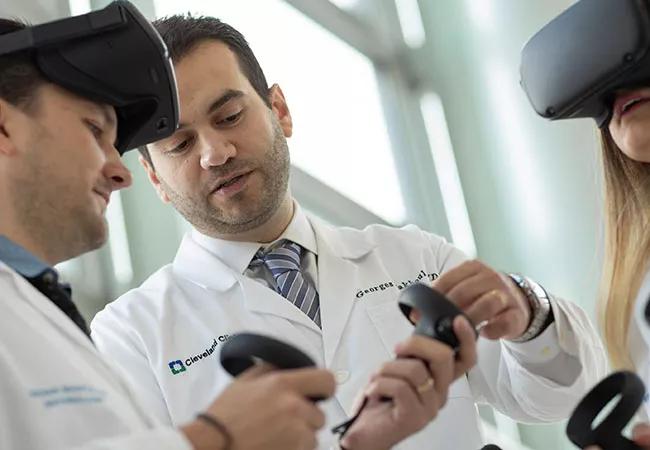How one nephrologist is enhancing renal physiology curricula

Soon medical students, residents and fellows will have access to an immersive, virtual reality teaching tool to enhance a renal physiology curricula. The device will integrate 3D printing and holographic computing to simulate mechanistic processes in nephron physiology and pathology.
Advertisement
Cleveland Clinic is a non-profit academic medical center. Advertising on our site helps support our mission. We do not endorse non-Cleveland Clinic products or services. Policy
The project, led by Georges Nakhoul, MD, Director of Cleveland Clinic’s Center for Chronic Kidney Disease and Associate Director of the Nephrology Fellowship Program in the Glickman Urological & Kidney Institute, will bring greater accessibility to a discipline that is often perceived as difficult to teach and learn.
According to a national survey of U.S. internal medicine non-nephrology subspecialty fellows, 31% of respondents reported that nephrology was the most difficult physiology course taught in medical school. The implication of this rigor – whether real or perceived among aspiring physicians – may negatively impact recruitment and training within the specialty.
“This challenge led us to consider new approaches to teach nephrology,” notes Dr. Nakhoul, “by taking advantage of novel technology in the marketplace and leveraging engineering expertise within our institution,” he says.
Dr. Nakhoul is partnering with Karl West, MS, Director of Medical Device Solutions in Cleveland Clinic’s Department of Biomedical Engineering, Lerner Research Institute to leverage this virtual learning platform. Mr. West and his colleagues have been closely involved with similar projects that leverage this technology, although this is the first to focus expressly on renal education.
Using a virtual reality headset, Facebook’s Oculus Quest, learners will be able to see animations of select parts of the nephron and observe physiologic and pathologic processes. They will also be able to interact with 3D models of enlarged nephron replicas to better understand the anatomy of the renal unit.
Advertisement
There will be several modules targeting different learning goals. “One will allow learners to experiment virtually with medications like diuretics and water pills and observe the effects of these interventions,” says Dr. Nakhoul.
He hopes this simulated experience will make scientific concepts, including the physiology and pathology of electrolytes, proximal tubule, water balance regulation and acid/base, more accessible than conventional learning modalities.
An important step, he says, will be to measure the utility of the program. “It’s great to implement innovative teaching technologies, but we must ascertain if it’s actually making a difference for learners. We have developed an evaluation plan to determine that.”
And if it proves beneficial, Dr. Nakhoul and his collaborators hope to make the software freely available (to those who have access to Oculus Quest.) “The goal would be to download the app on your phone, and make the program available to those who want it.”
“We saw an opportunity to improve an unmet need that will not only help Cleveland Clinic students and trainees but also the specialty at large,” he remarks. “We are eager to see its impact.”
Reference
Jhaveri KD, Sparks MA, Shah HH, et al. Why not nephrology? A survey of US internal medicine subspecialty fellows. Am J Kidney Dis. 2013;61:540-546.
Advertisement
Advertisement

Authors summarize the recent evidence and offer two clinical scenarios

Key considerations when diagnosing and managing severe hyponatremia

Clinicians should individualize dosing practices based on patient risk factors and preferences

Fully-automated process uses preop CT, baseline GFR to estimate post-nephrectomy renal function

Identifying barriers in the renal genetic assessment of Black patients

Getting patients to their goal blood pressure

Study highlights benefits of nephrologist-led urine sediment analysis

Using sequencing data to identify novel factors linked to kidney disease with unknown origin